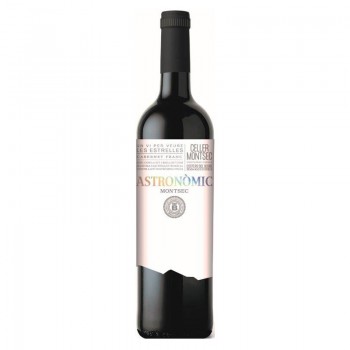Astronòmic
The first vintage of the Montsec Astronómico was produced in 2018. "The attack of the Cabernet Franc was of excellent quality and we knew that it had to be given a special treatment", comments the winery. Coupage:...

 Shipping Delivery 3-5 business days
Shipping Delivery 3-5 business days Save money Special offers every week
Save money Special offers every week Secure shopping Money back guarantee up to 15 days
Secure shopping Money back guarantee up to 15 days Can we help you? A team of professionals at your service
Can we help you? A team of professionals at your serviceThe continental nature of this region, far from the sea, kept it off trading routes for centuries, resulting in wines with characteristic features.
It was the first place in Catalonia where the Cabernet Sauvignon, Merlot and Chardonnay varieties were introduced, together with native varieties, and also where Californian winemaking techniques were adopted. In 1983, the Catalan Wine Institute and the Bodega de Raimat announced that the excellent winemaking quality of the Lleida region and local traditions should be overseen by a regulatory council. This helped promote the region and make Raimat wines hugely successful.
In 1986, an initial four subzones were created. In 1998, the geographical area of the DO Costers del Segre was expanded, with Pallars Jussà and Segrià being added as subzones. The region now has seven subzones: Artesa de Segre, Urgell, Garrigues, Pallars Jussà, Raimat, Segrià and Valles del Río Cuervo.
The predominant white varieties are the traditional Macabeo and Parellada. This gives the whites from the Costers del Segre region a more classic profile, i.e. light, fruity and acidulous. The successful acclimatisation of Chardonnay opened the door to wines with more modern characteristics, whether they're young wines or ones fermented in oak barrels, with greater structure and more varietal character.
The red varieties include Cabernet Sauvignon, Merlot, Syrah and Pinot Noir, as well as traditional varieties like Tempranillo, Garnacha and Trepat. The red wines have a robust aroma, a balanced flavour, and a good tannic structure, while in the mouth they're flavoursome, broad and structured.
Active filters
The first vintage of the Montsec Astronómico was produced in 2018. "The attack of the Cabernet Franc was of excellent quality and we knew that it had to be given a special treatment", comments the winery. Coupage:...
Geological and climate characteristics changed. The connecting link is the central basin of the River Segre, between the Pyrenees and the River Ebro, and the dry inland climate, away from maritime influences and defined by high levels of sunshine, low rainfall and persistent humidity from winter fogs. The vines are found between 200 and 1,100 metres above sea level.
The soil is calcareous topped with sand, with very little variation across the DO. The Artesa and Pallars subzones are the northernmost, with the highest altitude vineyards and a Pyrenean influence. Raimat, in the extreme east, has a gentle relief and continental climate. The Segrià subzone is typical of rainfed dryland. The Garrigues and the Riucorb Valleys are arid lands.
As for the red varieties, the Cariñena and Sansón dominate, which forms the basis of Empordà winemaking together with the Garnacha Tinta (known as Lledoner in the area). These traditional varieties are complemented by new varieties that are gradually being introduced, such as Tempranillo, Cabernet Sauvignon, Merlot and Syrah.
The dominant white varieties are the Garnacha Blanca, Garnacha Roja and Macabeo. In much smaller proportions are Moscatel, the traditional Xarel·lo, and the recently planted Chardonnay, Sauvignon Blanc and Gewürztraminer.
![]() ©2021 Viniscoop
©2021 Viniscoop
